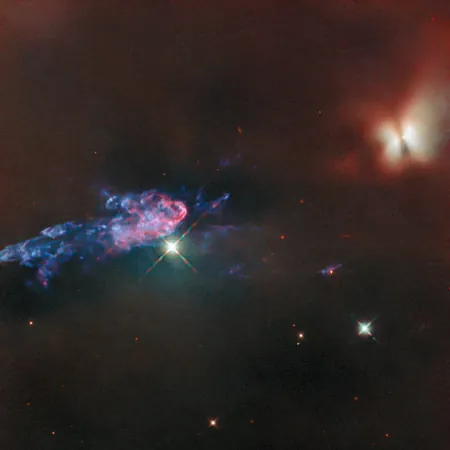
Hubble Unveils Spectacular Duo of Protostars in the Orion Nebula!
2025-01-13
Author: Li
Hubble Unveils Spectacular Duo of Protostars in the Orion Nebula!
In an exhilarating revelation from the cosmos, a stunning new image captured by the NASA/ESA Hubble Space Telescope showcases two fascinating protostars nestled within the Orion Nebula. This magnificent celestial phenomenon is located approximately 1,350 light-years away in the iconic constellation of Orion, famed for its starry belt and the bright stars that adorn it.
Known as NGC 1976, Messier 42, M42, and more, the Orion Nebula has been a celebrated celestial visitor since the dawn of recorded astronomy. First identified as a nebula in 1610, just a year following Galileo's groundbreaking use of the telescope, its captivating beauty has made it a perennial favorite for amateur and professional astronomers alike. Spanning roughly 24 light-years, the nebula is a vibrant nursery for young stars, allowing astronomers unique insights into stellar formation much akin to the phase our own Sun experienced over 4.6 billion years ago.
Hubble's latest observations reveal two specific protostars, HOPS 150 and HOPS 153, which were initially identified during the Herschel Orion Protostar Survey, conducted by the European Space Agency's Herschel Space Observatory. HOPS 150, located in the upper-right corner of the image, is a remarkable binary system comprising two young protostars that are interlinked in their celestial dance. Each of these forming stars is shrouded by a dusty disk from which they draw their material, nurturing their stellar growth.
In an exciting twist, the image also showcases a dark band bisecting the bright outlines of HOPS 150—this is a vast cloud of gas and dust, over 2,000 times wider than the distance from Earth to the Sun, cascading toward the protostars. The analysis of infrared emissions from HOPS 150 indicates that these stars are well on their journey toward maturity, marking a significant stage in their development.
To the left, a vibrant, intricate jet emerges from HOPS 153, a protostar still in its early stages, enmeshed in a dense, cold cloud of gas that Hubble cannot penetrate. Despite this, the jet is spectacularly visible as it collides with the surrounding material, illustrating the dynamic processes at play in the Orion Nebula.
The transformation of these protostars into fully developed stars will have profound repercussions on their surroundings. As HOPS 153 gathers gas, it generates powerful jets that release material and energy back into the cosmos, sculpting the surrounding space, heating the gas, and potentially influencing the birth of new stars nearby. Strikingly, this process could also impede HOPS 153's own growth, showcasing the delicate balance of stellar life.
As we gaze into the depths of space, the Orion Nebula serves as a magnificent reminder of the ongoing dance of creation occurring in the universe, where even the most subtle interactions contribute to the birth of stars, thereby igniting the cycle of life that characterizes our cosmos. Stay tuned for more cosmic revelations as astronomers continue to unlock the mysteries of our spectacular universe!

 Brasil (PT)
Brasil (PT)
 Canada (EN)
Canada (EN)
 Chile (ES)
Chile (ES)
 Česko (CS)
Česko (CS)
 대한민국 (KO)
대한민국 (KO)
 España (ES)
España (ES)
 France (FR)
France (FR)
 Hong Kong (EN)
Hong Kong (EN)
 Italia (IT)
Italia (IT)
 日本 (JA)
日本 (JA)
 Magyarország (HU)
Magyarország (HU)
 Norge (NO)
Norge (NO)
 Polska (PL)
Polska (PL)
 Schweiz (DE)
Schweiz (DE)
 Singapore (EN)
Singapore (EN)
 Sverige (SV)
Sverige (SV)
 Suomi (FI)
Suomi (FI)
 Türkiye (TR)
Türkiye (TR)
 الإمارات العربية المتحدة (AR)
الإمارات العربية المتحدة (AR)